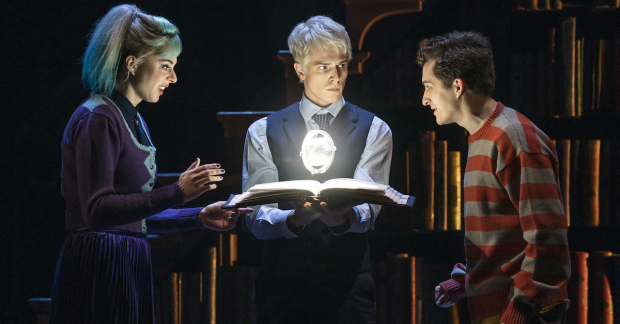How does Harry Potter and the Cursed Child work as a one-part play?
A bold new experiment for the epic production

Please note – this article originally ran on our sister-site, TheaterMania.
Is it possible to cut half the words from a play and still tell the same story? That is the experiment currently being conducted on Harry Potter and the Cursed Child, which recently reopened at Broadway's Lyric Theatre. A two-part epic when it originally premiered, Broadway'sHarry Potter and the Cursed Child (but, notably, not the West End iteration) has returned from the pandemic condensed into a single three-hour, 30-minute evening, performed in its entirety eight times a week.
The allure of marathon theatre has long existed for connoisseurs of the stage. Jonathan Kalb explores this phenomenon his book Great Lengths, which includes sections on Peter Brook's Mahabharata (11 hours) and Tony Kushner's Angels in America (a mere seven). But it is safe to say that members of this crowd have already had the opportunity to catch The Cursed Child in its original form or have permanently turned their noses up at it (a mistake). The future of The Cursed Child on Broadway, if there is to be one, is in the tourist market: fans of both Broadway and Harry Potter who would love to see their favourite wizard onstage but aren't prepared to dedicate seven hours of a trip to New York to do so. Now, they don't have to.

The basic story remains the same: All grown up, Harry Potter (Steve Haggard at the performance I attended) and Ginny Weasley (Diane Davis) are sending their own kids off to Hogwarts, including wayward middle son, Albus (James Romney). To everyone's surprise, he becomes best friends with Scorpius Malfoy (Bradley Dalton Richard), son of Harry's old nemesis, Draco (Aaron Bartz). Even more shocking, Albus is sorted into Slytherin. Without the natural wizarding talent of a Hermione Granger (Jenny Jules, authoritative as Minister for Magic), but haunted by his famous last name, Albus becomes a depressive recluse. But the recent discovery of a time-turner presents him with the opportunity to create his own legacy by correcting one of his father's historical mistakes.
Those familiar with the published script already know the speed of the exposition. Here, that process is kicked into hyper-drive: Years pass, the Hogwarts Express chugs along, Harry and Albus fight, and then suddenly everyone is doing a big group dance with wands (cape-swishing choreography by Steven Hoggett). It is disorienting enough for the audience, but even some of the actors stumble over their lines as they race through the first half-hour.

The sailing is much smoother after that, as the performers are allowed to settle into their characters and inhabit the magical world Tiffany has created with his team of designers: The ever-shifting set (by Christine Jones), transforming costumes (by Katrina Lindsay), cathedral lighting (by Neil Austin), and all-enveloping sound (by Gareth Fry) still constitute the most technically impressive show on Broadway. Austin and Fry collaborate particularly well with video designers Finn Ross and Ash J. Woodward on a recurring cue that seems to send shockwaves through the theatre (and had audience members all around me shuddering with delight).
The show features 36 actors, a remarkable number for a play (but down from the original 40 of the two-part version). Gone are notable characters like big friendly groundskeeper Hagrid and Lily Potter (Albus's little sister, who is mentioned but never seen). As disappointing as this may be for Harry Potter completists anticipating their favourite characters, the result is a much cleaner play that rarely diverts from the forward thrust of the plot. Sometimes it pays to kill your darlings.
Of course, no one is going to Harry Potter and the Cursed Child for a monumental work of drama. They're going to see magic onstage, and on all that front, the show delivers spectacularly. Jamie Harrison's illusions regularly receive showstopping applause, the kind which might make the actors jealous were it not for the fact that their performances are integral to making the magic seem real. If you suspend your disbelief just a little bit (it's not hard considering the level of artistry at work) you'll feel like a kid again, witnessing incredible wonders onstage.
It also helps that the house staff at the Lyric Theatre is one of the friendliest on Broadway, eager to ensure that everyone is having a great time. That matters when the price of two Broadway tickets could buy you a lot of other fun things (a spa day, a flight to Miami, dinner at many of New York's best restaurants). I can confidently tell readers that Harry Potter and the Cursed Child beats them all. It is absolutely worth your time and money.
But is it the same play as before? Not quite. Those interested in experiencing every excised line and character can read the published script, which always presented as another novel in the much-loved series — with plenty of room to sprawl. The leaner, meaner version onstage at the Lyric is actually a better play that has lost nothing in terms of production value. It is still the most magical show on Broadway.













